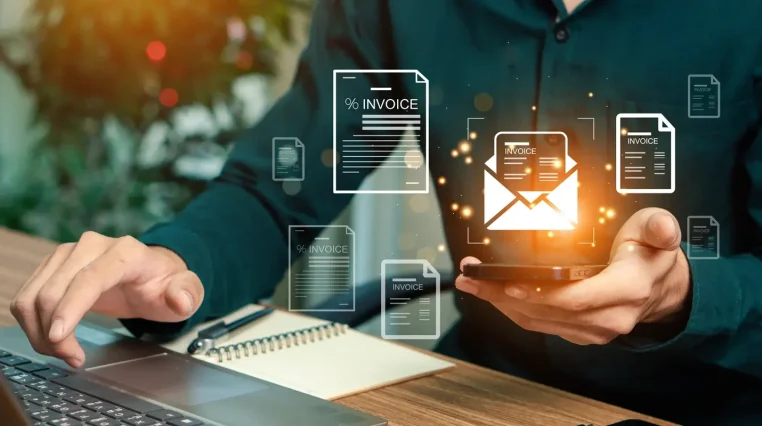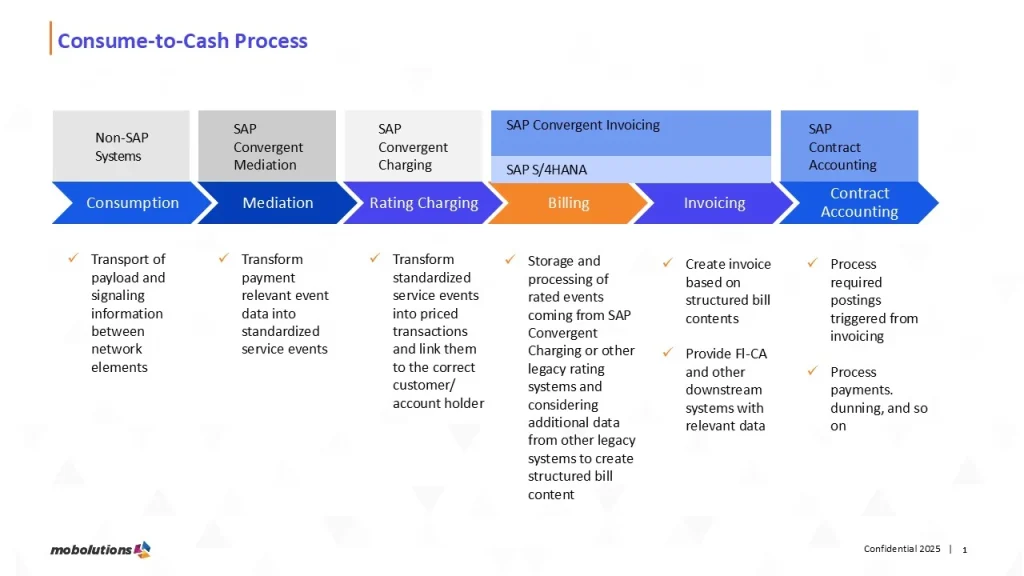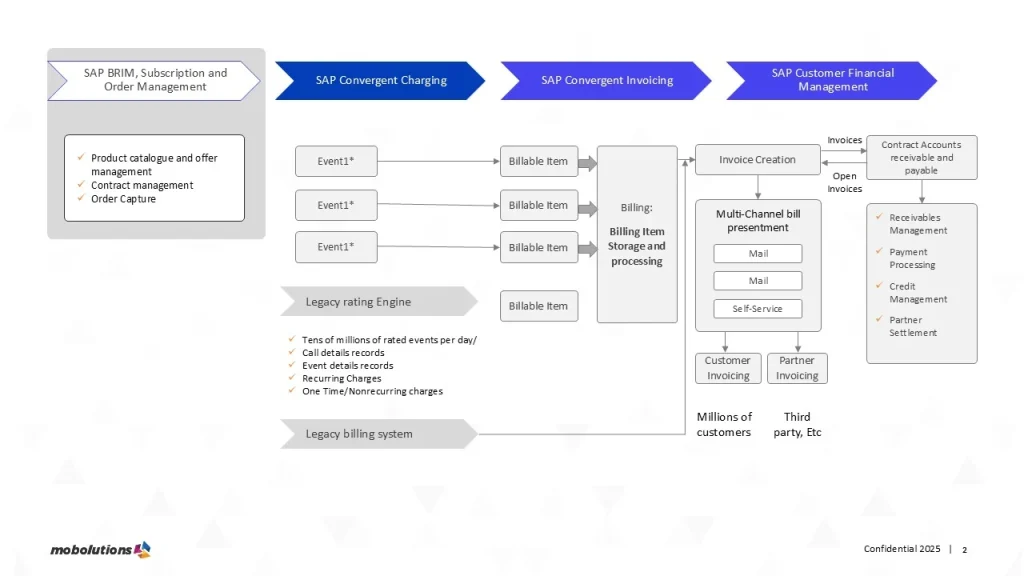Convergent invoicing in SAP is a process that integrates various invoicing and billing systems to create a unified, consolidated invoicing experience for businesses, especially those that deal with multiple business areas, customers, or service types. It is typically used in industries such as telecommunications, utilities, and subscription-based services, where customers might have multiple accounts or use multiple services that need to be billed together.
Key features of SAP Convergent Invoicing in SAP:
-
- Centralized Billing: It consolidates all invoices for different services (e.g., mobile phone usage, internet, or television) into one comprehensive bill, instead of issuing separate bills for each service. This helps businesses offer a seamless experience for their customers.
- Integration: It integrates with various modules in SAP, such as SAP Billing and Revenue Innovation Management (BRIM), SAP Convergent Charging, and SAP Customer Financial Management. These modules work together to manage billing, payments, and revenue recognition.
- Flexible Payment Options: It allows businesses to provide flexible payment terms and options, including support for different currencies, payment methods, and settlement processes.
- Automated Workflows: Convergent invoicing automates the creation, validation, and processing of invoices, reducing manual intervention and the possibility of errors. It can also handle adjustments and corrections as needed.
Why do we need Convergent Invoicing?
-
-
- Improved Customer Experience: Convergent invoicing simplifies billing for customers by offering a single, consolidated invoice, reducing confusion and providing more transparency in billing. Customers don’t have to keep track of multiple bills for different services or accounts.
- Operational Efficiency: By automating and consolidating invoicing, businesses can streamline their operations. There is less administrative work involved in managing multiple billing systems or issuing multiple invoices. This can save time and reduce costs.
- Better Revenue Management: It ensures better control over revenue recognition and reduces billing errors or delays. With one system handling all the invoicing, businesses can more accurately recognize their revenue and manage cash flow.
- Scalability: For businesses that offer multiple services or have customers with diverse billing needs, sap convergent invoicing provides the flexibility and scalability to grow without needing to implement multiple systems.
- Compliance and Reporting: Convergent invoicing helps with better compliance as businesses can standardize their invoicing process and generate reports that ensure they meet legal and regulatory requirements.
-
In SAP BRIM (Billing and Revenue Innovation Management), Convergent Invoicing plays a key role by acting as the central invoicing engine that brings together charges from multiple billing sources into one unified invoice.
Here’s an overview of its purpose and advantages:
Purpose of Convergent Invoicing (CI):
-
-
-
- Unification of Billing Sources:
- Consolidates charges from different systems like SAP Convergent Charging (SAP CC), SAP Contract Accounting (FI-CA), and external systems.
- Ensures all service, usage, subscription, and product charges appear on a single customer invoice.
- Streamlined Invoicing Process:
- Automates and centralizes the creation of invoices based on billable items (pre-invoice data) from various sources.
- Customer Experience:
- Delivers a single, consolidated invoice for the end customer, improving transparency and reducing confusion.
- Flexibility & Control:
- Allows business rules to control how and when items are invoiced (e.g. thresholds, timing, bundling).
- Integration with Financials (FI-CA):
- Transfers finalized invoices to SAP FI-CA for accounts receivable, collections, and payments processing.
- Unification of Billing Sources:
-
-
SAP BRIM with Convergent Invoicing Process:
-
-
- Usage Collection → SAP Convergent Charging
- Charging Results → Transformed into Billable Items
- Billable Items → Processed by SAP Convergent Invoicing
- Invoice Creation → Consolidated and formatted
- Invoice Transfer → To SAP FI-CA for financial follow-up
-
Benefits:
-
-
- Improves operational efficiency
- Reduces billing errors
- Enhances customer satisfaction
- Supports complex, multi-service business models
-
If you’re working with industries like telecom, utilities, media, or subscription-based services, sap convergent invoicing is essential for handling high-volume, high-complexity billing scenarios.
Use Case Example: Telecom Company
Scenario: A telecom provider offers internet, mobile, and digital TV services. A telecommunications provider delivers internet, mobile, and digital TV services. Each service has separate usage patterns and pricing models.
Steps with Convergent Invoicing:
-
-
- Usage Captured: Customers use data, call minutes, and TV on demand.
- Charging: SAP Convergent Charging (SAP CC) calculates charges based on tariffs and usage.
- Billable Items: Charges for all services are converted into standardized billable items.
- Convergent Invoicing: SAP CI consolidates all items into one invoice.
- Invoice Sent: One invoice is sent to the customer, showing detailed service breakdowns.
- FI-CA Processing: The invoice is handed over to SAP FI-CA for dunning, payment, and receivables management.
-
This simplifies operations, enhances the customer experience with a single bill, and reduces billing errors across services.
Centralize and Simplify Billing Across Multiple Services
SAP Convergent Invoicing enables businesses to combine multiple billing streams—such as usage-based charges, subscription fees, product sales, and third-party services—into a single, accurate, and customer-friendly invoice.
Key Aims of Convergent Invoicing:
-
-
- One Invoice for All Charges
-
- Deliver a single invoice to the customer regardless of how many different services or systems generated the charges.
-
- Integration of Multiple Billing Sources
-
- Consolidate billing data from SAP and non-SAP systems, including:
- SAP Convergent Charging (usage-based)
- SAP Subscription Billing
- CRM systems
- External billing engines
-
- Enhance Customer Transparency
-
- Provide clear, itemized invoices that are easier for customers to understand and trust.
-
- Automate Invoicing Logic
-
- Use flexible invoicing rules (e.g., thresholds, billing cycles, service bundling) to control how and when invoices are generated.
-
- Support Complex Business Models
-
- Ideal for industries with high-volume, multi-service, or subscription-based offerings like:
- Telecommunications
- Media & entertainment
- Utilities
- Public transportation
- High-tech service providers
-
- Seamless Financial Integration
-
- Payment processing
- Send invoices to SAP FI-CA
- Dunning & collections
- Account reconciliation
-
- One Invoice for All Charges
-
Conclusion:
In short, Convergent Invoicing in SAP is essential for businesses that need to consolidate their billing operations across multiple services or accounts. It helps to improve efficiency, reduce billing errors, and enhance the customer experience by offering a unified approach to invoicing.







